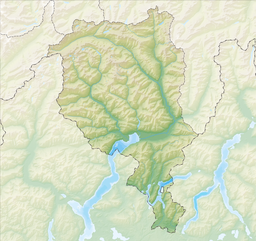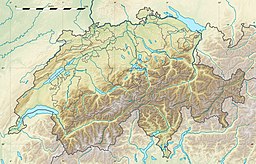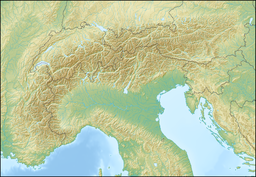| Lake Cadagno | |
|---|---|
| Lago di Cadagno (Italian) | |
 | |
| Location | Piora Valley, Ticino |
| Coordinates | 46°32′59″N 8°42′41″E / 46.54972°N 8.71139°E |
| Type | meromictic, reservoir |
| Catchment area | 2.51 km2 (0.97 sq mi) |
| Basin countries | Switzerland |
| Max. length | 842 m (2,762 ft) |
| Max. width | 423 m (1,388 ft) |
| Surface area | 0.26 km2 (0.10 sq mi) |
| Max. depth | 21 m (69 ft) (summer) |
| Water volume | 2,420,000 m3 (1,960 acre⋅ft) (summer) |
| Surface elevation | 1,921.2 m (6,303 ft) |
 | |
Lake Cadagno (Italian: Lago di Cadagno) is a meromictic lake in the Piora valley (canton of Ticino), Switzerland. As one of a few meromictic lakes in Europe, it is the object of numerous scientific studies. The Piora valley - located in the Saint-Gotthard Massif (central Swiss Alps) in the Southern part of Switzerland near Airolo at an altitude of 1921 m above sea level - is a landlocked alpine valley whose scientific value has been recognized for more than two centuries. In the past, the lake was used as a reservoir.
Lake Cadagno is a rare example of crenogenic meromixis. Its waters show a permanent stratification due to a natural geological phenomenon. The lower abounds with dissolved mineral salts (sulphate, magnesium, calcium, carbonate) originating from sublacustrine springs, whereas the separate upper layer is permanently oxygenated. Anaerobic phototrophic bacteria – among them Chromatium okenii—thrive between the two layers where they find the ideal conditions for their development. Such an ecosystem provides a good opportunity to study the metabolisms connected with eutrophication on a stable model, as it is well known that one of the advanced stages of eutrophication is biogenic meromixis.


